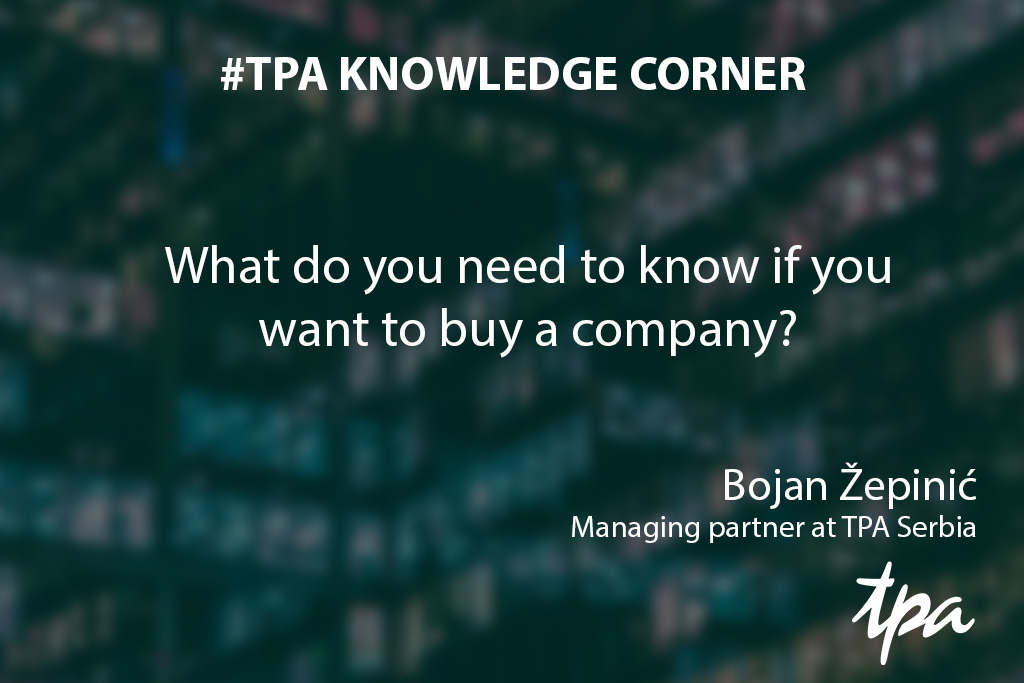
Business strategists often say that it is cheaper to buy a business than to create one. This approach, combined with easily available and cheap external financing, led to creation of favorable market conditions for potential buyers and their acquisitions. Our economy has also proven as fertile ground for expansion, primarily of foreign strategic and financial investors, through the takeover of domestic companies.
None of the potential buyers plan to do a bad job. Nonetheless, many buyers, including experienced ones with the right intentions, negotiate about transactions that they later regret. The classic failures in a single transaction by a customer are:
– poor planning and implementation of the purchase process
– incorrect assessment of the capacity and performance of the company being bought (market, financial, human, etc.)
– the absence of the expected synergy that the transaction was supposed to achieve. The key premise of the synergy is that the new business will be larger than all of its parts together. But, it doesn’t always happen in M&A transactions.
– How to bypass these or some other traps that arise for the buyer in the process of buying a company?
It is clear from the above that buying a company is a complex and challenging process. In order to complete it successfully, the buyer should keep in mind the following steps:
- Gathering an adequate team. This refers to an adequate combination of internal, legal, financial and commercial experts with externally engaged people only for these purposes. What will be the ratio of the number of internal and external experts depends, above all, on the internal capacities of buyers and the fact whether they have an internal M&A team. Constant communication and synchronization of these two teams is crucial for the success of the buyer in the transaction. This is the task of the key people in the buyer’s management team.
- Setting acquisition goals. What does the buyer want to achieve by buying another company? Common answers would be: entering a new market, increasing existing market share, taking over new products, technologies (or key people), reducing costs through increasing production capacity, and so on. The question that potential buyers should ask themselves is whether they could achieve these goals through alternative growth methods (organic growth, franchising, rationalization, etc.)?
- Making an acquisition plan. Making this plan, above all, refers to the way of selecting a potential target company, but also to the budget for the purchase, time frame, territory, structure of the transaction, etc. One of the more interesting questions in this process is how the buyer gets to the seller? The answer to this question, however, is not simple. Sometimes the buyer already knows and cooperates with the target company, so taking over (logical) is the next step in cooperation. Buyer can also use publicly available databases (APRs or business portals) to identify potential target companies through size criteria, industry-specific, and so on. In case the buyer does not know the market where he/she plans to carry out the acquisition, it is common to contact investment banks and other intermediaries who may have mandates from the other seller to try to sell the target company.
- Establishing contact with the target company. While it doesn’t sound like an important part, it may turn out that the way a potential buyer and seller get in touch is, to a large extent, decisive for the further course. In most transactions, it is possible to assess whether buyer or seller is more willing to sell/buy the target company. Establishing such a balance in negotiations can create a strategic advantage for one or the other side that can be materialized through negotiations.
Position of the previous owner and key people after takeover. Communication by the buyer is also particularly important where the transaction is structured in a way that the seller remains (as a co-owner or manager) and is still tied to the company that has been sold, in whole or in part. In the case when the company gets a new “boss” and the old “boss” remains can be confusing, not only in internal relations, but also in external ones (with key customers, suppliers, etc.). This duality can particularly affect key employees in the acquired company, who have to be fully informed about the new ownership and management structure in order to continue doing their job or to decide whether they want to stay in company.